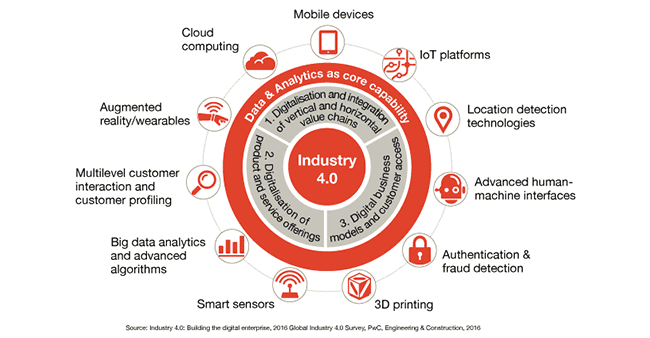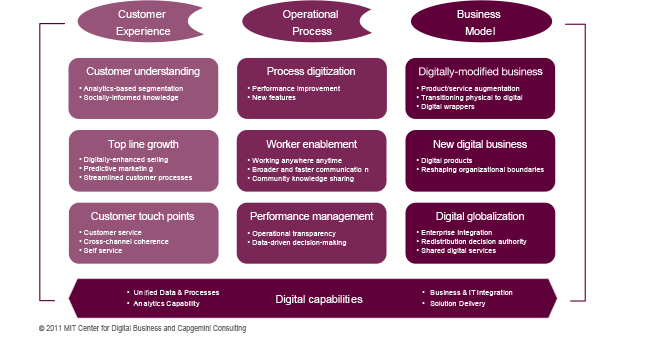
Top 5 digital transformation frameworks in 2020
>
Reviewed: The top 5 digital transformation frameworks in 2020
We review 👍👎 digital transformation frameworks from the world’s top digital transformation consulting companies. PwC, McKinsey, Accenture, EY, Gartner, CapGemini, MIT, Cognizant, Altimeter, Ionology.
In this article, we provide you a directory listing of digital transformation frameworks and what makes each framework🌟🌟🌟 special. We will evaluate each framework based on its own merits in a moment. However, to get started, we have a few general comments about what makes one framework better than another.
What are hallmarks of a top digital transformation framework?
Digital transformation frameworks, like any kind of framework, give decision-makers a starting point. Frameworks offer checklists of what needs to get done, and sequence to order what needs doing. However, frameworks shouldn’t be prescriptive. Instead, the authors of the framework should invite the user to hack and mod their DX framework, to suit circumstances.
Digital transformation frameworks show people at different levels of the organization how to cooperate 👏 to make digital change possible.
HOW WE REVIEWED EACH FRAMEWORK
Each review is based on what is published in the public domain. While most authors gave some explanation, there was little published in the way of how to apply the framework. Therefore, our reviews are first impressions at best. A personal demonstration of each framework by the author would reveal more detail and give a more accurate review.
We have based our reviews upon these four dimensions. We believe a DX framework should allow you to:
We valued customer-centric. We believe the customer must be the reason for digital change. We value opportunities and constraints. Many frameworks address opportunity, however organizations big and small face constraints. We value company culture.
Lastly, we value simplicity. We appreciate a personal demonstration would improve the reviews of each framework. However, the framework should be simple to apply.
FRAMEWORKS WHICH DIDN'T MAKE TOP 5
Accenture’s digital business strategy framework seems to have the right ingredients. Information, applications, operations, and platforms are placed at the bottom where you would expect to find them. Accenture places vision at the top. Vision or beliefs are key to addressing the culture of the organization.
Criticism: where do I start? It didn’t seem intuitive.
KPMG has identified six dimensions of i4.0, as part of its DX framework. At a glance, it looks solid. One of the pieces of the framework offers a digital smorgasbord which was a little worrying. There was no mention of customers which frightened me.
Overall KPMG doesn’t seem to bring anything new to the table, except perhaps a better visualize transformation compared to others.
A few frameworks we’d like to review, but were not able to, due to lack of information. Altimeter, Ionology, Deloitte and EY all offer digital transformation frameworks, which I am sure, if demonstrated personally, could be reviewed.
TOP 5 DIGITAL TRANSFORMATION FRAMEWORKS
We scored frameworks against each value and came up with a total score out of five. A high score is five. A low score is one. Tied equally in the first place are MIT, CapGemini, and DXC with respective scores of 3.5 out of 5.
It is hard to beat either of these three frameworks. All three scored 3.5 overall and also scored 5/5 for customer-centricity. Sources claim MIT and CapGemini were responsible for writing the first digital transformation framework. CapGemini had a rock-solid approach to company culture and MIT’s simplicity of six building blocks was hard to beat.
DXC Technologies is the new kid on the block. The digital native underdog stands to challenge the status quo.
The second position was taken by McKinsey’s work of art called the 4Ds. The 4Ds ranked high for customer-centricity. In third place is Gartner with its digital transformation framework. Overall Gartner’s digital transformation ranked highest for company culture.
Let’s begin with fifth place and work our way to the top of the leaderboard.
5. PwC digital transformation framework
PwC tells us digital change should be rooted in “Industry 4.0”. Industry 4.0 refers to the fourth industrial revolution.
The outer ring labeled data and analytics is clever. This framework will provide more accurate intel for business leaders to make decisions in stages 1-3.
Digitisation of product and service offerings (stage 2) is clear. CapGemini’s DX framework encourages organizations to go beyond digital wrapping traditional products, and instead build new products that are digitally native.
The framework places Industry v4.0 at the heart of digital change. Shouldn’t the customer be here?
The DX framework names types of technology — smart sensors and 3D printing. Naming technology creates a few problems. The framework dates quickly. Technology changes and technology today is redundant tomorrow.
It can create a digital smorgasbord. Business leaders are encouraged to pick what looks tasty and add it to their plate. This kind of thinking is why organizations deploy digital kiosks unnecessarily. Steve Jobs said:
you need to think about customer experience and work backward to the technology.
The framework does not reference company culture. It recognizes opportunities but what about organizational constraints?
4. Cognizant digital transformation framework
Cognizant has found four common elements that apply to most companies making digital change in both the B2C and B2B markets.
Where PwC’s digital transformation model made a vague reference to a customer, Cognizant has an entire piece devoted to digitizing the customer experience. This piece includes customer insights, an aspect covered by MIT’s five building blocks to digital transformation.
In making digital change, Cognizant’s DX framework recognizes new pricing models are important. The framework is relatively easy-to-use.
Unfortunately, I had mostly criticism for this framework. Parked under ‘customer’ is digital marketing. Digital marketing is not strictly speaking part of digital transformation, nor does it necessarily help customers. Most customers will tell you, they hate advertising.
I was surprised the digitization of the organization did not include a piece on culture.
The framework mentions tapping into partner ecosystems. This business concept was relevant 30 years ago. It is common sense.
3. Gartner digital transformation framework
Gartner wrote a six-step digital transformation framework, enabling CIOs and other business leaders to build a successful digital enterprise.
Gartner, like Accenture, put shared beliefs first. They call stage one of their DX framework ‘shared understanding’.
Step 2 of the Gartner digital transformation framework suggests putting in place the right leadership. This decision is backed by research that suggests skill gaps are one reason why digital change fails.
Shared understanding or shared belief is essential. Technology transformation is useless unless people transform. The staff needs to understand and share the same belief as the CEO about why digital change makes sense. It is inside-out.
Step 3 is powerful. While other DX frameworks touch on shared beliefs and culture, Gartner goes further suggesting the organization be supported by a digital excellence team. Think of these people as coaches and mentors.
Gartner’s DX framework does not appear to address the customer, to the degree that McKinsey’s framework does. While it’s prudent to address leadership before making change, this concept has been around a long time and is broader.
2. McKinsey digital transformation framework
McKinsey has a proprietary DX framework called the 4Ds. According to the McKinsey framework, the 4D’s of digital transformation are Discovery, Design, Deliver, and De-risk.
McKinsey 4Ds are on fire. It is the first DX framework I have reviewed where the customer is first, again and again. McKinsey put the customer first in the Discovery phase — looking at customer behavior trends.
In the second phase — Design — the customer gets another hug. This time McKinsey talks specifically about designing and building customer journeys. Customer journeys are an important driver of customer experience. Customer journeys form one of the blocks in McKinsey’s six building blocks for creating a high performing digital enterprise. DXC’s DX framework uses customer journeys to identify new opportunities.
The last phase encourages the organization to reinvest profits made from quick wins to de-risk the business against change fatigue. This scenario is highly likely and I have personally used this approach to help businesses. PwC encourages organizations to create a budget for a pilot project and then scale up funding.
McKinsey’s model expects an enterprise organization to behave like a startup. A startup and enterprise organization are diametrically opposed. More on this subject at the end of the review.
1. CapGemini digital transformation framework
CapGemini’s DX framework digitally transforms three key areas of an enterprise: customer experience, operational processes, and business models. Within each of the three pillars, different elements are changing. These nine elements form a set of building blocks for digital transformation.
I think CapGemini’s digital transformation framework rocks. It is one of the better ones. While you may not like the font and the monochromatic color palette, you have got to love their three stages.
Stage one customer experience. This is about understanding the customer and thinking about new kinds of customer journeys – precisely the ingredients prescribed by McKinsey.
I think CapGemini has got the right sequence which will lead to what McKinsey calls quick wins. Start with the customer experience and move to greater issues of complexity.
Like Accenture, CapGemini places digital technology at the bottom suggesting it supports rather than leads. If we cast stage 1 as front-of-office, then stage two is back-of-office. This is the operational changes required to deliver the value propositions. CapGemini DX framework is not the only framework that addresses value propositions. Value propositions get a mention in EYs framework. MIT’s DX framework calls value propositions ‘offers’.
The fonts and color? Seriously, there is a lot of 7-point type and the application of ‘what’ and ‘how’ is not obvious.
1. MIT digital transformation framework
MITs framework was easy to review thanks to the anecdotal information provided by Jeanne Ross. The DX frameworks we addressed in this review are akin to a flow chart. MIT’s five building blocks to digital transformation framework is more like a stack of building blocks.
There is a lot of emphasis on customers. Like PwCs data and analytics core competency ring, MIT points organizations to develop a reservoir of intelligence 🤔 about both customer problems and solutions.
The accountability block tries to break down organizational barriers as a means of transforming. Create a startup culture where it is possible to make mistakes and still succeed.
I liked this sentence from Ross:
Companies need to adopt a new framework of accountability organized around components rather than functions, product lines, or geographies.
This is about aligning the entire business around the customer.
MIT’s five building blocks to digital transformation framework begins with operations, not customers. One block is devoted to what is called the external developer platform. The external developer platform is a marketplace. The idea of not building everything and sourcing externally is not a new idea. Business advisors since the 1970s have been telling business leaders to focus on core competencies.
1. DXC Technology digital transformation framework
In the digital world according to DXC, the consumer is in charge and will define your next move. Asymmetric competition from unexpected sources will be the norm. Winners maintain control while they minimize their asset base.
Like MIT and CapGemini, DXC’s digital transformation framework puts customers first.
DXC really knows how to put the customer first. Their Digital Customer Experience piece is comprehensive. Like CapGemini and McKinsey, they touch upon customer journeys and take it one step further.
DXC claims these journeys need to be ‘intelligent’, ‘digital-first’ and ‘omni-channel’. Their Business Model Innovation is very cool. It helps anticipate asymmetric competition. Asymmetric competition is stuff like how Apple could start by offering Apple Pay, and then launch a digital bank.
Like MIT and Cognizant, this DX framework gives basic business advice. Keep what you manage to a minimum. Focus on core competency and outsource what you can. This is common sense and distracts us from what is important.
Closing remarks
Many of the frameworks we uncovered are steeped in years of academic research. Frameworks developed by PwC, McKinseys and Ionology alike. However, be warned. Other DX frameworks are akin to the thinking of a three-year-old. Seriously, these frameworks are appalling. They are generic project management workflows, that you and I could apply to home gardening. Or building the kid’s cubby house. Or installing a new toilet (flush now).
While digital transformation frameworks from MIT, CapGemini, and DXC Technologies stand out, you won’t be taking these frameworks 😂 home. There are no user guides in the public domain, so you will have to become a paying customer first.
Even with the help of consultants and a few hundred thousand dollars, don’t expect to roll out these 👎 frameworks quickly. They are not simple and require a lot of customization.
I would like to offer an alternative digital transformation framework called the 4Qs.
Between late 2019 to mid-2020, we conducted over 100 interviews with digital transformation consultants. During each interview, the consultants were shown how to apply the 4Qs to digital transformation and asked to a complete survey.
Here are some of the 👍 results of the survey.

grab the
whitepaper
DIGITAL TRANSFORMATION PLAYBOOKS
DIGITAL TRANSFORMATION ASSESSMENT TOOLS
DIGITAL TRANSFORMATION SLIDESHARE RESOURCES

learn more
about the
4Qs
















